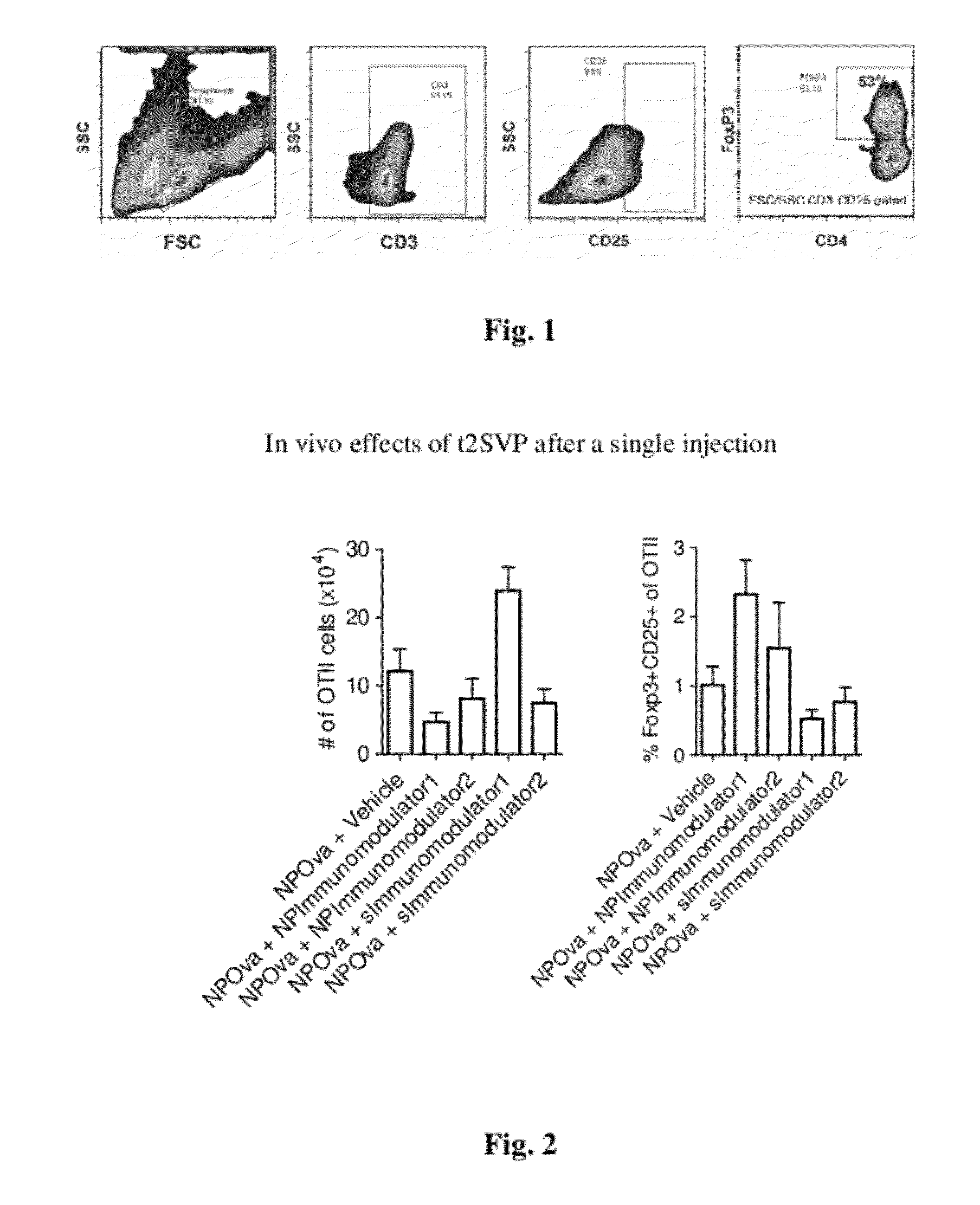Tolerogenic synthetic nanocarriers to reduce immune responses to therapeutic proteins
a synthetic nanocarrier and immune response technology, applied in the direction of liposome delivery, peptide/protein ingredients, powder delivery, etc., can solve the problem of over-all systemic downregulation of the immune system, reduce the incidence of undesired therapeutic-protein immune responses, reduce the frequency of effector t cells reacting, and increase the frequency of suppressive regulatory t or b cells.
- Summary
- Abstract
- Description
- Claims
- Application Information
AI Technical Summary
Benefits of technology
Problems solved by technology
Method used
Image
Examples
example 1
Immune Response of Synthetic Nanocarriers with Coupled Rapamycin with and without Ovalbumin Peptide (323-339)
Materials
[0220]Ovalbumin peptide 323-339, a 17 amino acid peptide known to be a T and B cell epitope of Ovalbumin protein, was purchased from Bachem Americas Inc. (3132 Kashiwa Street, Torrance Calif. 90505; Part #4065609). Rapamycin was purchased from TSZ CHEM (185 Wilson Street, Framingham, Mass. 01702; Product Catalogue #R1017). PLGA with a lactide:glycolide ratio of 3:1 and an inherent viscosity of 0.75 dL / g was purchased from SurModics Pharmaceuticals (756 Tom Martin Drive, Birmingham, Ala. 35211; Product Code 7525 DLG 7A). Polyvinyl alcohol (85-89% hydrolyzed) was purchased from EMD Chemicals (Product Number 1.41350.1001).
[0221]Solution 1: Ovalbumin peptide 323-339 @ 20 mg / mL in dilute hydrochloric acid aqueous solution. The solution was prepared by dissolving ovalbumin peptide in 0.13 M hydrochloric acid solution at room temperature.
[0222]Solution 2: Rapamycin @ 50 mg / ...
example 2
Mesoporous Silica Nanoparticles with Coupled Ibuprofen (Prophetic)
[0234]Mesoporous SiO2 nanoparticle cores are created through a sol-gel process. Hexadecyltrimethyl-ammonium bromide (CTAB) (0.5 g) is dissolved in deionized water (500 mL), and then 2 M aqueous NaOH solution (3.5 mL) is added to the CTAB solution. The solution is stirred for 30 min, and then Tetraethoxysilane (TEOS) (2.5 mL) is added to the solution. The resulting gel is stirred for 3 h at a temperature of 80° C. The white precipitate which forms is captured by filtration, followed by washing with deionized water and drying at room temperature. The remaining surfactant is then extracted from the particles by suspension in an ethanolic solution of HCl overnight. The particles are washed with ethanol, centrifuged, and redispersed under ultrasonication. This wash procedure is repeated two additional times.
[0235]The SiO2 nanoparticles are then functionalized with amino groups using (3-aminopropyl)-triethoxysilane (APTMS)....
example 3
Liposomes Containing Cyclosporine A (Prophetic)
[0238]The liposomes are formed using thin film hydration. 1,2-Dipalmitoyl-sn-glycero-3-phosphocholine (DPPC) (32 μmol), cholesterol (32 μmol), and cyclosporin A (6.4 μmol) are dissolved in pure chloroform (3 mL). This lipid solution is added to a 50 mL round-bottom flask, and the solvent is evaporated on a rotary evaporator at a temperature of 60° C. The flask is then flushed with nitrogen gas to remove remaining solvent. Phosphate buffered saline (2 mL) and five glass beads are added to the flask, and the lipid film is hydrated by shaking at 60° C. for 1 h to form a suspension. The suspension is transferred to a small pressure tube and sonicated at 60° C. for four cycles of 30s pulses with a 30 s delay between each pulse. The suspension is then left undisturbed at room temperature for 2 h to allow for complete hydration. The liposomes are washed by centrifugation followed by resuspension in fresh phosphate buffered saline.
PUM
| Property | Measurement | Unit |
|---|---|---|
| diameter | aaaaa | aaaaa |
| diameter | aaaaa | aaaaa |
| diameter | aaaaa | aaaaa |
Abstract
Description
Claims
Application Information
 Login to View More
Login to View More - R&D
- Intellectual Property
- Life Sciences
- Materials
- Tech Scout
- Unparalleled Data Quality
- Higher Quality Content
- 60% Fewer Hallucinations
Browse by: Latest US Patents, China's latest patents, Technical Efficacy Thesaurus, Application Domain, Technology Topic, Popular Technical Reports.
© 2025 PatSnap. All rights reserved.Legal|Privacy policy|Modern Slavery Act Transparency Statement|Sitemap|About US| Contact US: help@patsnap.com



